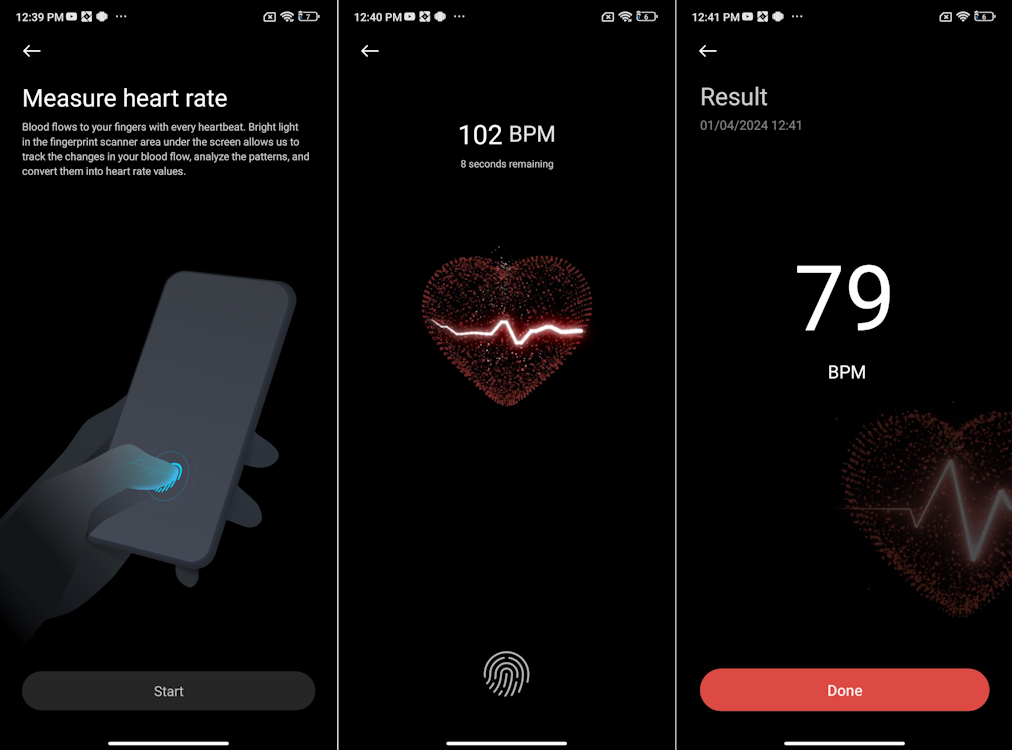Just today, Xiaomi launched the Redmi Note 13 series in India, and I was honestly unperturbed when the Note 13 Pro+ first arrived at the Beebom office. I mean, how many phones does Xiaomi launch in a year? Probably like 50, and I don’t look forward to all of them. But then, my coworker asked me if I knew that the new Note 13 Pro and 13 Pro+ came with a heart rate monitor. I didn’t. That’s exactly when and why I decided to shake this tree and see what falls.
Heart Rate Monitoring on Redmi Note 13 Pro/ Pro+
See, don’t get me wrong, but when the Google Pixel 8 Pro came with a temperature sensor, I had the biggest “why?” written all over my face. Not going to lie, I had that same reaction upon seeing this bizarre feature on the Redmi Note 13 Pro models. The in-display fingerprint sensor, a first for the Redmi Note series, doubles as a heart rate monitor.
It sounds good on paper, BUT even Xiaomi did not talk about it during the launch event. There was just one slide during the presentation that mentioned this feature, and it got me intrigued.
This Xiaomi feature has been so under the radar that even I got to know about it during the event. Upon doing a bit of research, I realized the feature is far from new. In fact, Xiaomi integrated this feature into the Xiaomi 13 earlier this year. Also, a similar feature has exited within the Mi Health app way back in 2020. This allowed Xiaomi phones to use the camera flash as a heart rate monitor and get a scan.
If you remember, Samsung did this way earlier with the Galaxy S5 back in 2014 and took the tech world by storm. However, now that we have it integrated into the in-display fingerprint sensor, it makes things a lot more convenient. So yes, it did look like an interesting feature to have on your phone, at least on paper. But, how does it perform?
Testing Heart Rate Detection on Redmi Note 13 Series
Being the nerd that I am and having the resources to back me up, I had to put this cool new feature to the test. With that, I started gathering things that I needed for this test. An Apple Watch Series 7 from a rich coworker? Check. Another Xiaomi phone that I didn’t even know had this feature. Big check. Lastly, a couple of sleepy coworkers who can be blackmailed into helping me? Heck yeah.
The feature in itself is very straightforward to use. All you have to do is open the dedicated Heart Rate app that the Redmi phone has. Then, I just placed my finger on the fingerprint sensor as it prompted me to and let it do the trick.

Now, I pitted the heart rate detection feature on the Redmi Note 13 Pro/ Pro+ against the Xiaomi 13 Pro and the Apple Watch 7, which is undeniably super accurate. And well, here is how my test (that absolutely no one asked for) went:
Subject Redmi Note 13 Pro+ Xiaomi 13 Pro Apple Watch 7 Person 1 78 BPM 92 BPM 113 BPM Person 2 74 BPM 77 BPM 81 BPM Person 3 69 BPM 87 BPM 75 BPM Person 4 91 BPM 79 BPM 85 BPM
If you take a look at this data, you will see that the Xiaomi 13 Pro was somehow getting us better results than the Note 13 Pro+. But, I just feel that the heart rate sensor on the new Redmi phones was throwing numbers with the hope that it hit. Moreover, the sensor on the Note 13 Pro variants worked through my jacket sleeve too, and the reading was way off.
For example, Person 1 is actually me and when recording my heart rate with the three devices, I had a massive triple sneeze. The Apple Watch Series 7 immediately recorded that spike in heart rate and went from 98 BPM to 113 BPM, steadying at somewhere around 101 BPM after a couple of seconds.
However, the heart rate sensor on the Xiaomi phones did not register any of that. Then, quite a few times, even though we did not move our fingers during the heart rate scan, we were hit with a ‘Start over’ message.
I’m sure by now you get the idea of what to expect from this gimmicky feature, where the fingerprint sensor doubles as a heart rate sensor. Surely, it can’t beat the accuracy of fitness bands and even the company does not want you to think it is medically accurate.
From my understanding, Redmi was adding an in-display fingerprint sensor to the Note series for the first time, so it wanted to bulk up on features, and heart rate detection does sound compelling on paper from a user’s POV.
However, yeah, if you see strange readings from this sensor, don’t go ahead and book a hospital bed. Please consult with your doctor instead. Overall, this is just another feature that you will forget even exists on your phone, like the Pixel 8 Pro temperature sensor or the Glyph lights on Nothing Phone. Except, the last two actually can come in handy at times.